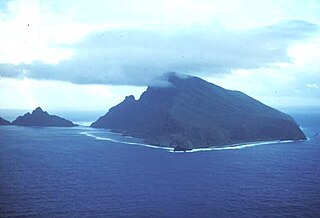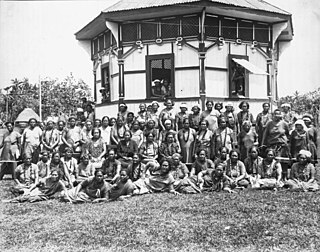
Transport in Samoa includes one international airport situated on the north west coast of Upolu island, paved highways reaching most parts of the two main islands, one main port in the capital Apia and two ports servicing mainly inter island ferries for vehicles and passengers between the two main islands, Upolu and Savai'i.

The Samoan Islands are an archipelago covering 3,030 km2 (1,170 sq mi) in the central South Pacific, forming part of Polynesia and the wider region of Oceania. Administratively, the archipelago comprises all of Samoa and most of American Samoa. The two Samoan jurisdictions are separated by 64 km (40 mi) of ocean.

Satupa'itea is a large village district with four sub-villages on the south east coast of Savai'i Island in Samoa.

Pio Taofinu'u, S. M. was a Roman Catholic cardinal and Archbishop of Samoa-Apia. Born in the village of Falealupo on the island of Savai'i in Samoa, he was the first Polynesian bishop and cardinal. He was made a Cardinal by Pope Paul VI in the Consistory of 5 March 1973, of the Title of St. Onofrio. His father was Taofinu'u Solomona and his mother, Mau.
Apia Park is a multi-function sports complex located in Apia, the capital of Samoa. Primarily used for rugby union events, Apia Park is the home stadium of the Samoa national rugby union team, Manu Samoa. It is also a venue for association football.

Patamea is a village on the island of Savai'i in Samoa. While most villages on Savai'i are situated near the sea, Patamea is situated inland, away from the coast. The village is in the Gaga'emauga political district near the central north coast of the island.

Piula Theological College is a Methodist training institution in Samoa. It was established in 1868 in Lufilufi on the north coast of Upolu island after its initial beginnings in 1859 at Satupa'itea on the south coast of Savai'i island. The Methodist Mission in Samoa purchased the land at the Methodist leaning district and later named their training center Piula Theological College. The name Piula is a transliteration of the biblical name Beulah which means married.
Alfred James Tattersall was a New Zealand photographer who lived in Samoa for most of his life and contributed a significant collection of images of the Pacific Island country and its peoples during the colonial era. Tattersall moved to Samoa in 1886 to work as an assistant in the studio of J. Davis. When Davis died in 1893 Tattersall over his studio and negative collection. He went on to live in Samoa from 1886 to 1951, including the volatile era when Britain, Germany and the United States were vying for control of the Samoa Islands. Many of his photographs are significant in the history of Samoa and covered eras such as German Samoa followed by the country's administration under New Zealand which saw the rise of the pro-independence Mau movement.

Vaipouli College is a secondary school on Savai'i island in Samoa. The college is co-educational, open to male and female students from Year 9 - 13. The college is also known as Salafai College, in reference to Salafai, another name for the island of Savai'i.
These are some Samoan plant names in alphabetical order in the Samoan language and their corresponding descriptions in English. Many are used in traditional medicines in the Samoa Islands comprising Samoa and American Samoa.
Samoa College is a secondary school in Samoa officially opened in 1953. It is co-educational and teaches from years 9 to 13. It is in Apia on the island of Upolu and is considered the main college in the country. The early college and curriculum was modeled on secondary schools in New Zealand, reflecting the country's colonial history.

Western Samoa Mandate then Western Samoa Trust Territory were the official name of Western Samoa during its civil administration by New Zealand between 1920, six years after that country had terminated the German rule, and Samoan independence in 1962.















